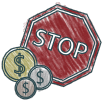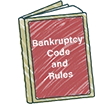Chapter 7 Bankruptcy for Credit Card Debt Relief
A Chapter 7 bankruptcy case provides clients with an opportunity to eliminate most or all of their debts, granting them a fresh financial start. This option is especially effective for handling significant credit card debt and other unsecured debts, such as personal loans and medical bills. For clients struggling to pay their current obligations and facing creditor harassment, collection activities, and damaging credit, Chapter 7 can offer substantial relief.
i) Initiating a Chapter 7 Case and the “Automatic Stay”
The Chapter 7 case begins by filing a bankruptcy petition, schedules, and a statement of financial affairs with the bankruptcy court. These documents detail the client’s assets, liabilities, income, and expenses. During an intake session, the law firm gathers the necessary information, including bank statements, tax returns, income verification, and bills. Before filing, the client must complete a pre-filing credit counseling session. Once filed, the bankruptcy triggers an “automatic stay,” halting creditor collection efforts, wage garnishments, and bank account restrictions.
ii) Issue of Potential “Equity” in Assets
A Chapter 7 trustee will meet with the client to determine whether any assets have equity that could be sold to pay off creditors. In most cases, Chapter 7 is considered a “no asset” case if the client’s assets are not worth enough to cover creditors’ claims. Certain exemptions, such as New York’s homestead exemption, protect the client’s property, including up to $150,000 of equity in their home.
iii) Issue of “Avoidable Transfers”
“Avoidable transfers” can complicate a Chapter 7 case. These include preferential payments to creditors made within 90 days of filing or transfers made to family members for less than fair value within a year of filing. Avoidable transfers can be challenged by the trustee and reversed under bankruptcy law.
iv) Income Level Considerations
To qualify for Chapter 7, a client must pass the means test, which assesses income relative to household size and necessary expenses. If the client’s income is above the state’s median, a detailed review of allowable expenses may still allow eligibility. If the client does not meet the requirements, Chapter 13 bankruptcy may be an alternative.
v) Issue of “Abusive” Debt
Creditors may scrutinize any large cash advances or balance transfers made shortly before filing for bankruptcy. In such cases, it may be best to wait before filing to avoid complications in the bankruptcy process.
vi) Avoiding Judicial Liens Against the Client’s Home
If a creditor has placed a judicial lien on the client’s property, a motion may be filed to avoid the lien in Chapter 7. This motion can help preserve the client’s homestead exemption and prevent the lien from affecting their ability to keep their home.
vii) Concluding a Bankruptcy Case and the Bankruptcy “Discharge”
The ultimate goal of a Chapter 7 case is to obtain a discharge, which legally forgives the client’s debts. Once the discharge is granted, the client is no longer responsible for most unpaid debts, with a few exceptions such as student loans, most taxes, and child or spousal support.
viii) Benefits of Chapter 7 and Our Law Office’s Role
Chapter 7 is a popular choice for individuals burdened with debt, as it can provide fast relief—typically in just four months. This process helps clients eliminate excessive credit card debt and other unsecured debts. However, Chapter 7 cases can be complex, especially when issues like equity, income, or avoidable transfers are involved. Having a bankruptcy attorney, like the Law Office of Ronald D. Weiss, P.C., is crucial to navigating these complexities and ensuring the case progresses smoothly.
We frequently represent clients from Queens and New York, helping them discharge overwhelming credit card debt. Our firm provides comprehensive guidance and support throughout the Chapter 7 bankruptcy process, ensuring that clients can move forward with financial relief.














